Accounting Thought Development: Financial Reporting Analysis
VerifiedAdded on 2023/04/20
|14
|3616
|484
Report
AI Summary
This report provides a critical analysis of current developments in accounting thought, focusing on financial reporting practices. It begins by examining the limitations of financial reports in accurately representing an organization's financial position and profits, and then explores the CoCoA model, which proposes a shift to exit price valuation. The report also assesses whether the development of conceptual frameworks serves primarily to benefit the accounting profession, potentially as a political strategy to ensure its survival and legitimacy. Finally, it describes three techniques for evaluating the theory of modified historical cost accounting, including current cost accounting and historical cost methods. The report concludes with an overview of how these different approaches impact financial statements and decision-making within business organizations.
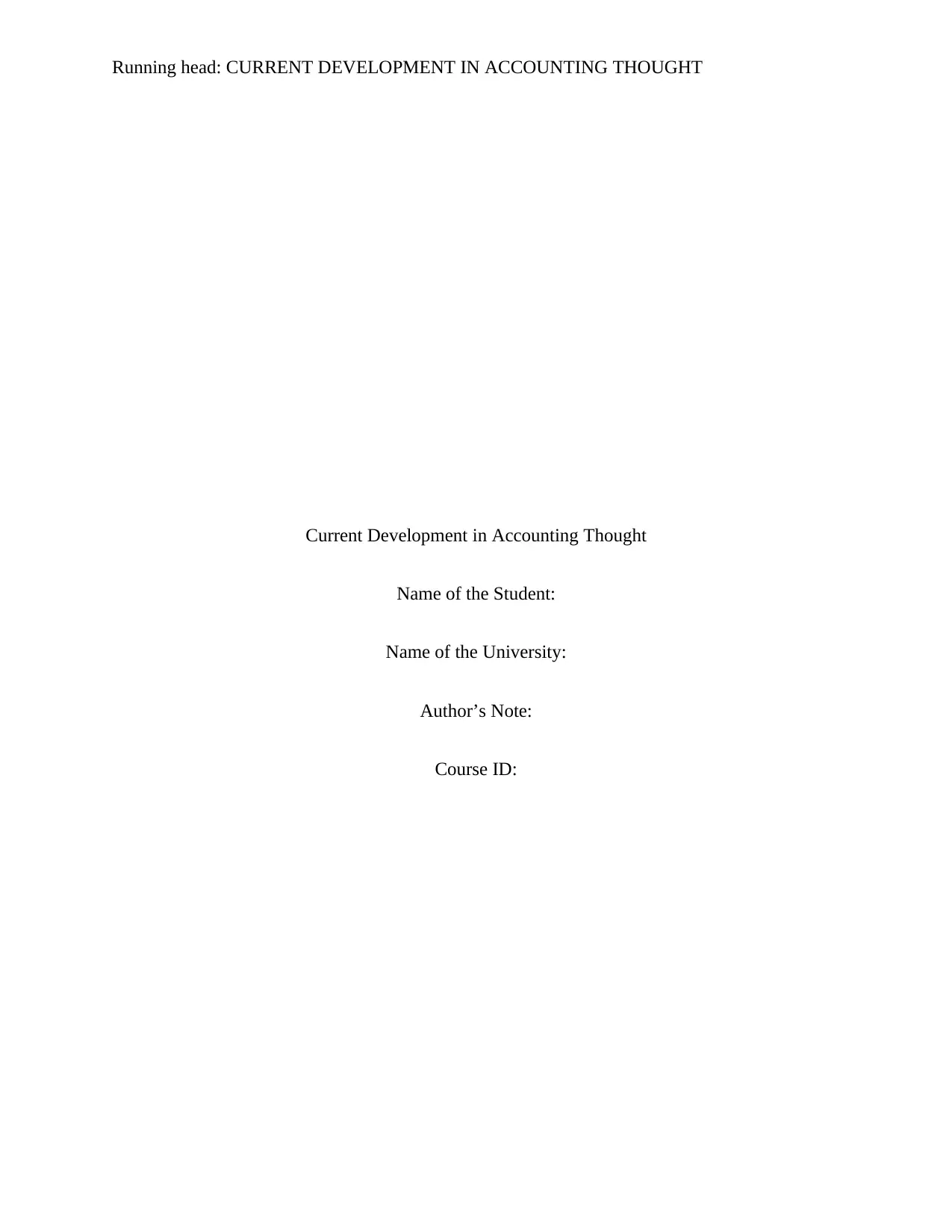
Running head: CURRENT DEVELOPMENT IN ACCOUNTING THOUGHT
Current Development in Accounting Thought
Name of the Student:
Name of the University:
Author’s Note:
Course ID:
Current Development in Accounting Thought
Name of the Student:
Name of the University:
Author’s Note:
Course ID:
Paraphrase This Document
Need a fresh take? Get an instant paraphrase of this document with our AI Paraphraser
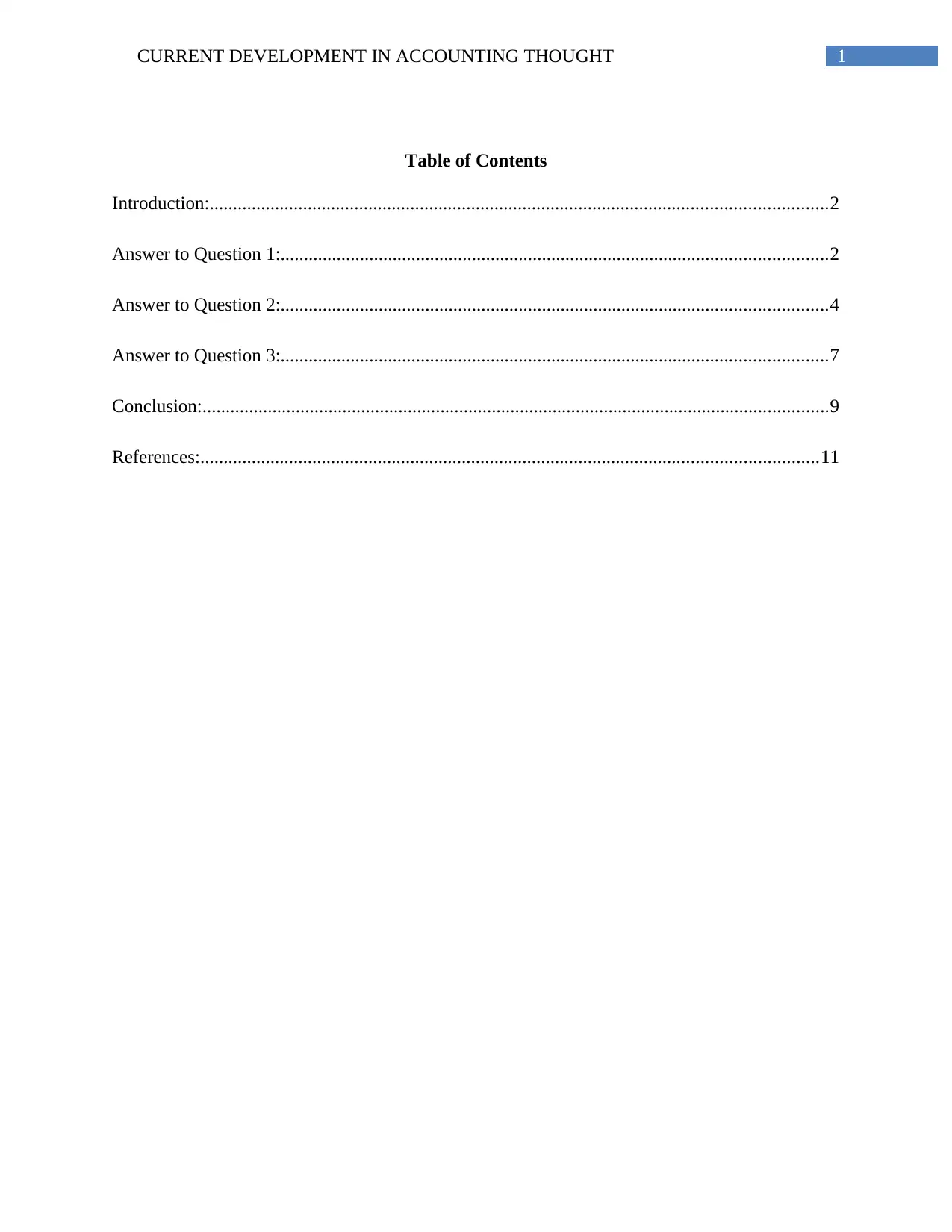
1CURRENT DEVELOPMENT IN ACCOUNTING THOUGHT
Table of Contents
Introduction:....................................................................................................................................2
Answer to Question 1:.....................................................................................................................2
Answer to Question 2:.....................................................................................................................4
Answer to Question 3:.....................................................................................................................7
Conclusion:......................................................................................................................................9
References:....................................................................................................................................11
Table of Contents
Introduction:....................................................................................................................................2
Answer to Question 1:.....................................................................................................................2
Answer to Question 2:.....................................................................................................................4
Answer to Question 3:.....................................................................................................................7
Conclusion:......................................................................................................................................9
References:....................................................................................................................................11
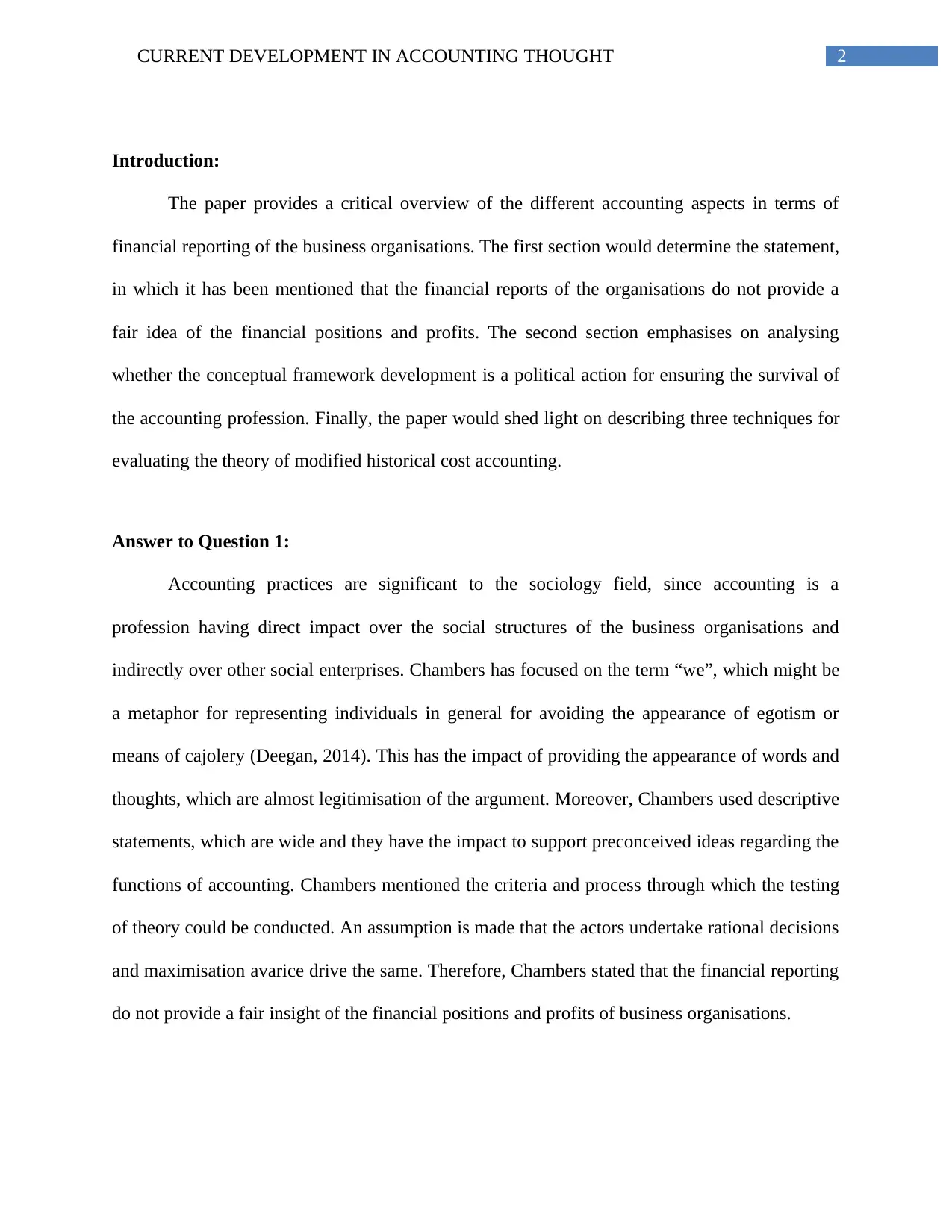
2CURRENT DEVELOPMENT IN ACCOUNTING THOUGHT
Introduction:
The paper provides a critical overview of the different accounting aspects in terms of
financial reporting of the business organisations. The first section would determine the statement,
in which it has been mentioned that the financial reports of the organisations do not provide a
fair idea of the financial positions and profits. The second section emphasises on analysing
whether the conceptual framework development is a political action for ensuring the survival of
the accounting profession. Finally, the paper would shed light on describing three techniques for
evaluating the theory of modified historical cost accounting.
Answer to Question 1:
Accounting practices are significant to the sociology field, since accounting is a
profession having direct impact over the social structures of the business organisations and
indirectly over other social enterprises. Chambers has focused on the term “we”, which might be
a metaphor for representing individuals in general for avoiding the appearance of egotism or
means of cajolery (Deegan, 2014). This has the impact of providing the appearance of words and
thoughts, which are almost legitimisation of the argument. Moreover, Chambers used descriptive
statements, which are wide and they have the impact to support preconceived ideas regarding the
functions of accounting. Chambers mentioned the criteria and process through which the testing
of theory could be conducted. An assumption is made that the actors undertake rational decisions
and maximisation avarice drive the same. Therefore, Chambers stated that the financial reporting
do not provide a fair insight of the financial positions and profits of business organisations.
Introduction:
The paper provides a critical overview of the different accounting aspects in terms of
financial reporting of the business organisations. The first section would determine the statement,
in which it has been mentioned that the financial reports of the organisations do not provide a
fair idea of the financial positions and profits. The second section emphasises on analysing
whether the conceptual framework development is a political action for ensuring the survival of
the accounting profession. Finally, the paper would shed light on describing three techniques for
evaluating the theory of modified historical cost accounting.
Answer to Question 1:
Accounting practices are significant to the sociology field, since accounting is a
profession having direct impact over the social structures of the business organisations and
indirectly over other social enterprises. Chambers has focused on the term “we”, which might be
a metaphor for representing individuals in general for avoiding the appearance of egotism or
means of cajolery (Deegan, 2014). This has the impact of providing the appearance of words and
thoughts, which are almost legitimisation of the argument. Moreover, Chambers used descriptive
statements, which are wide and they have the impact to support preconceived ideas regarding the
functions of accounting. Chambers mentioned the criteria and process through which the testing
of theory could be conducted. An assumption is made that the actors undertake rational decisions
and maximisation avarice drive the same. Therefore, Chambers stated that the financial reporting
do not provide a fair insight of the financial positions and profits of business organisations.
⊘ This is a preview!⊘
Do you want full access?
Subscribe today to unlock all pages.

Trusted by 1+ million students worldwide
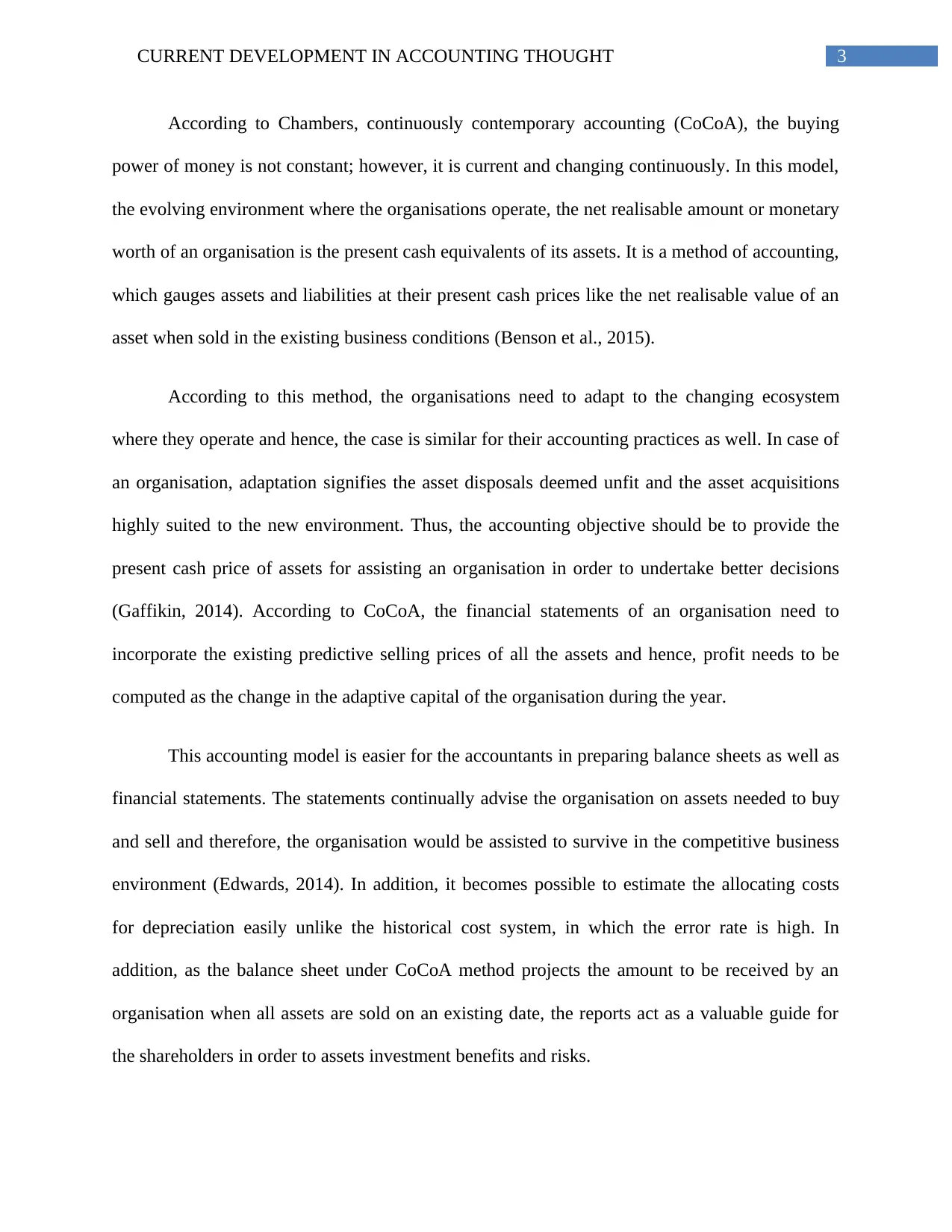
3CURRENT DEVELOPMENT IN ACCOUNTING THOUGHT
According to Chambers, continuously contemporary accounting (CoCoA), the buying
power of money is not constant; however, it is current and changing continuously. In this model,
the evolving environment where the organisations operate, the net realisable amount or monetary
worth of an organisation is the present cash equivalents of its assets. It is a method of accounting,
which gauges assets and liabilities at their present cash prices like the net realisable value of an
asset when sold in the existing business conditions (Benson et al., 2015).
According to this method, the organisations need to adapt to the changing ecosystem
where they operate and hence, the case is similar for their accounting practices as well. In case of
an organisation, adaptation signifies the asset disposals deemed unfit and the asset acquisitions
highly suited to the new environment. Thus, the accounting objective should be to provide the
present cash price of assets for assisting an organisation in order to undertake better decisions
(Gaffikin, 2014). According to CoCoA, the financial statements of an organisation need to
incorporate the existing predictive selling prices of all the assets and hence, profit needs to be
computed as the change in the adaptive capital of the organisation during the year.
This accounting model is easier for the accountants in preparing balance sheets as well as
financial statements. The statements continually advise the organisation on assets needed to buy
and sell and therefore, the organisation would be assisted to survive in the competitive business
environment (Edwards, 2014). In addition, it becomes possible to estimate the allocating costs
for depreciation easily unlike the historical cost system, in which the error rate is high. In
addition, as the balance sheet under CoCoA method projects the amount to be received by an
organisation when all assets are sold on an existing date, the reports act as a valuable guide for
the shareholders in order to assets investment benefits and risks.
According to Chambers, continuously contemporary accounting (CoCoA), the buying
power of money is not constant; however, it is current and changing continuously. In this model,
the evolving environment where the organisations operate, the net realisable amount or monetary
worth of an organisation is the present cash equivalents of its assets. It is a method of accounting,
which gauges assets and liabilities at their present cash prices like the net realisable value of an
asset when sold in the existing business conditions (Benson et al., 2015).
According to this method, the organisations need to adapt to the changing ecosystem
where they operate and hence, the case is similar for their accounting practices as well. In case of
an organisation, adaptation signifies the asset disposals deemed unfit and the asset acquisitions
highly suited to the new environment. Thus, the accounting objective should be to provide the
present cash price of assets for assisting an organisation in order to undertake better decisions
(Gaffikin, 2014). According to CoCoA, the financial statements of an organisation need to
incorporate the existing predictive selling prices of all the assets and hence, profit needs to be
computed as the change in the adaptive capital of the organisation during the year.
This accounting model is easier for the accountants in preparing balance sheets as well as
financial statements. The statements continually advise the organisation on assets needed to buy
and sell and therefore, the organisation would be assisted to survive in the competitive business
environment (Edwards, 2014). In addition, it becomes possible to estimate the allocating costs
for depreciation easily unlike the historical cost system, in which the error rate is high. In
addition, as the balance sheet under CoCoA method projects the amount to be received by an
organisation when all assets are sold on an existing date, the reports act as a valuable guide for
the shareholders in order to assets investment benefits and risks.
Paraphrase This Document
Need a fresh take? Get an instant paraphrase of this document with our AI Paraphraser
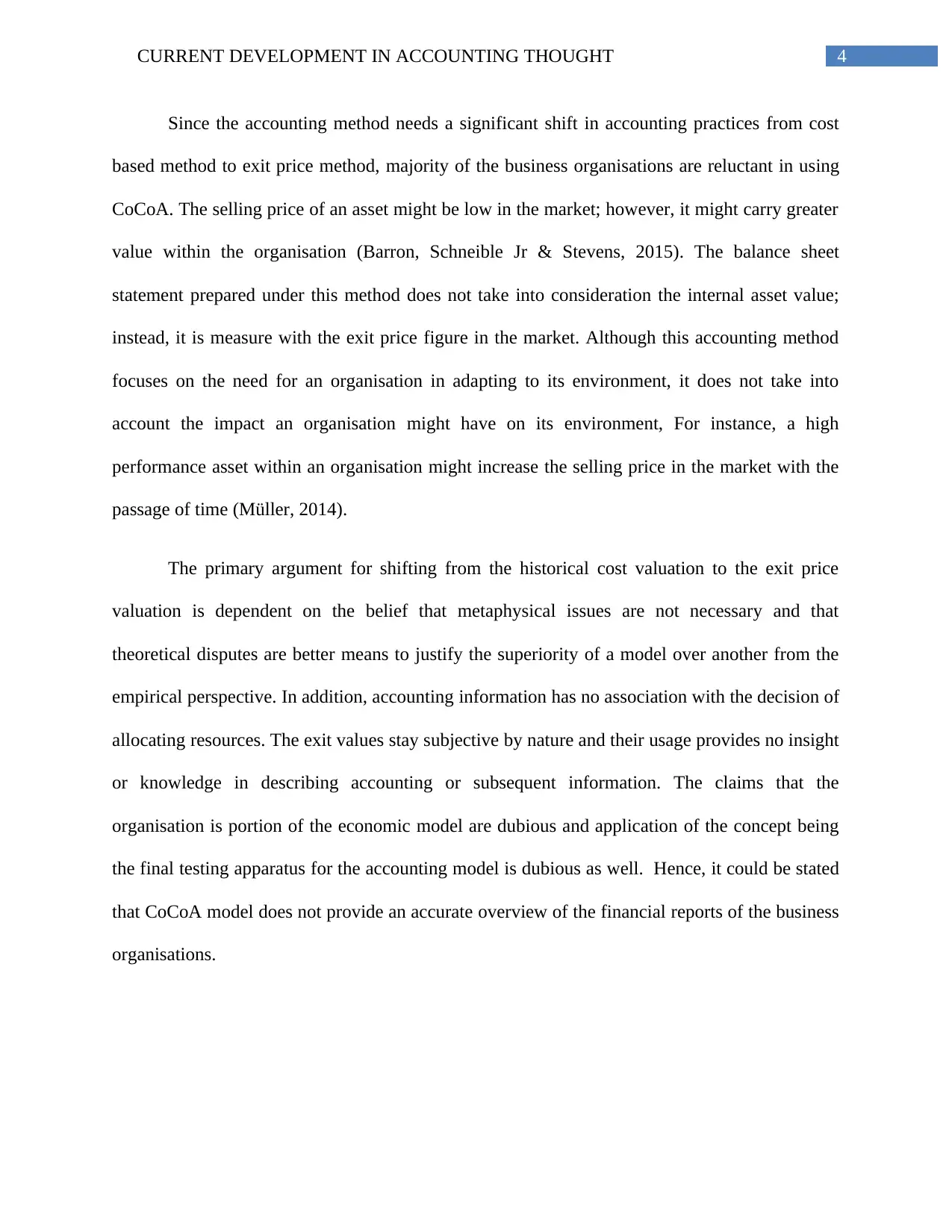
4CURRENT DEVELOPMENT IN ACCOUNTING THOUGHT
Since the accounting method needs a significant shift in accounting practices from cost
based method to exit price method, majority of the business organisations are reluctant in using
CoCoA. The selling price of an asset might be low in the market; however, it might carry greater
value within the organisation (Barron, Schneible Jr & Stevens, 2015). The balance sheet
statement prepared under this method does not take into consideration the internal asset value;
instead, it is measure with the exit price figure in the market. Although this accounting method
focuses on the need for an organisation in adapting to its environment, it does not take into
account the impact an organisation might have on its environment, For instance, a high
performance asset within an organisation might increase the selling price in the market with the
passage of time (Müller, 2014).
The primary argument for shifting from the historical cost valuation to the exit price
valuation is dependent on the belief that metaphysical issues are not necessary and that
theoretical disputes are better means to justify the superiority of a model over another from the
empirical perspective. In addition, accounting information has no association with the decision of
allocating resources. The exit values stay subjective by nature and their usage provides no insight
or knowledge in describing accounting or subsequent information. The claims that the
organisation is portion of the economic model are dubious and application of the concept being
the final testing apparatus for the accounting model is dubious as well. Hence, it could be stated
that CoCoA model does not provide an accurate overview of the financial reports of the business
organisations.
Since the accounting method needs a significant shift in accounting practices from cost
based method to exit price method, majority of the business organisations are reluctant in using
CoCoA. The selling price of an asset might be low in the market; however, it might carry greater
value within the organisation (Barron, Schneible Jr & Stevens, 2015). The balance sheet
statement prepared under this method does not take into consideration the internal asset value;
instead, it is measure with the exit price figure in the market. Although this accounting method
focuses on the need for an organisation in adapting to its environment, it does not take into
account the impact an organisation might have on its environment, For instance, a high
performance asset within an organisation might increase the selling price in the market with the
passage of time (Müller, 2014).
The primary argument for shifting from the historical cost valuation to the exit price
valuation is dependent on the belief that metaphysical issues are not necessary and that
theoretical disputes are better means to justify the superiority of a model over another from the
empirical perspective. In addition, accounting information has no association with the decision of
allocating resources. The exit values stay subjective by nature and their usage provides no insight
or knowledge in describing accounting or subsequent information. The claims that the
organisation is portion of the economic model are dubious and application of the concept being
the final testing apparatus for the accounting model is dubious as well. Hence, it could be stated
that CoCoA model does not provide an accurate overview of the financial reports of the business
organisations.
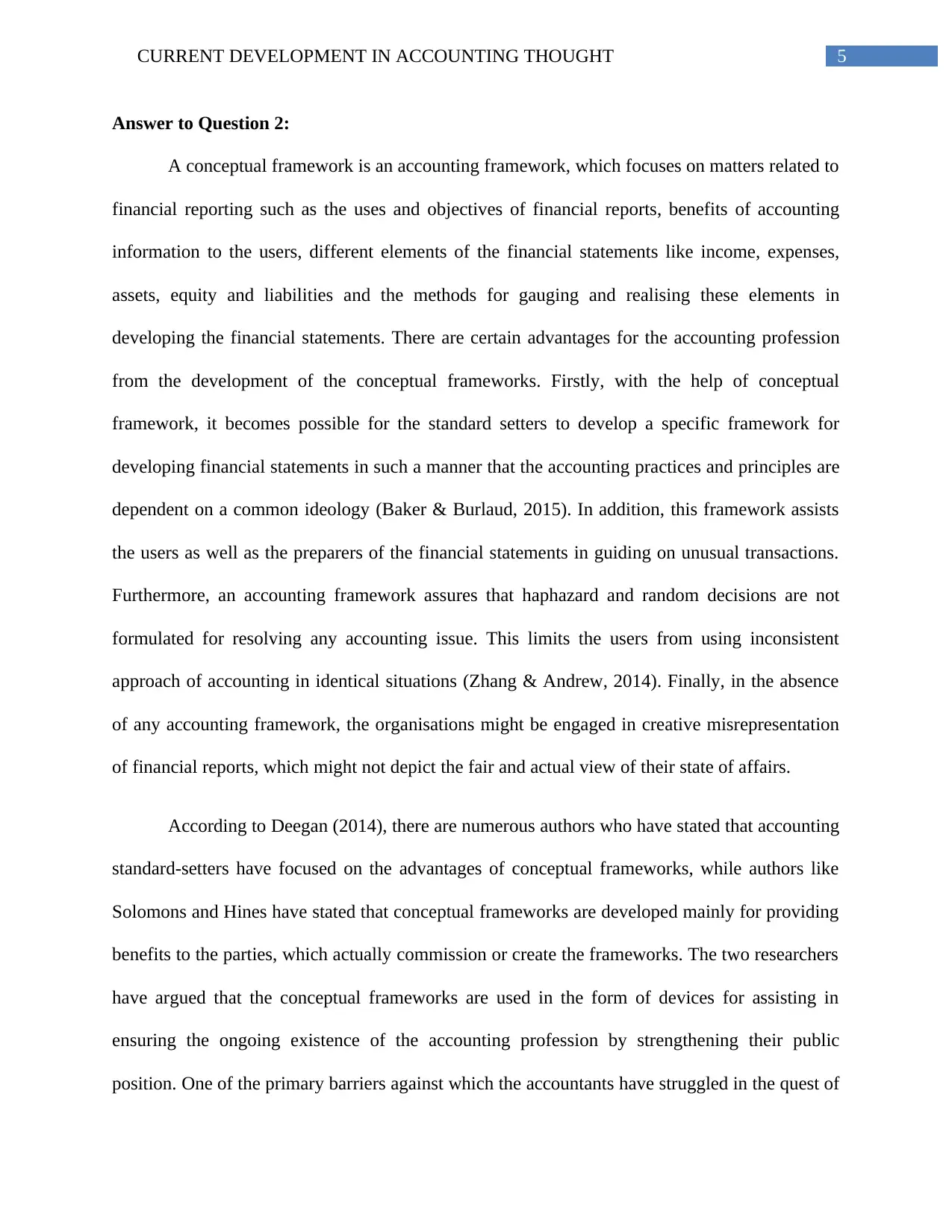
5CURRENT DEVELOPMENT IN ACCOUNTING THOUGHT
Answer to Question 2:
A conceptual framework is an accounting framework, which focuses on matters related to
financial reporting such as the uses and objectives of financial reports, benefits of accounting
information to the users, different elements of the financial statements like income, expenses,
assets, equity and liabilities and the methods for gauging and realising these elements in
developing the financial statements. There are certain advantages for the accounting profession
from the development of the conceptual frameworks. Firstly, with the help of conceptual
framework, it becomes possible for the standard setters to develop a specific framework for
developing financial statements in such a manner that the accounting practices and principles are
dependent on a common ideology (Baker & Burlaud, 2015). In addition, this framework assists
the users as well as the preparers of the financial statements in guiding on unusual transactions.
Furthermore, an accounting framework assures that haphazard and random decisions are not
formulated for resolving any accounting issue. This limits the users from using inconsistent
approach of accounting in identical situations (Zhang & Andrew, 2014). Finally, in the absence
of any accounting framework, the organisations might be engaged in creative misrepresentation
of financial reports, which might not depict the fair and actual view of their state of affairs.
According to Deegan (2014), there are numerous authors who have stated that accounting
standard-setters have focused on the advantages of conceptual frameworks, while authors like
Solomons and Hines have stated that conceptual frameworks are developed mainly for providing
benefits to the parties, which actually commission or create the frameworks. The two researchers
have argued that the conceptual frameworks are used in the form of devices for assisting in
ensuring the ongoing existence of the accounting profession by strengthening their public
position. One of the primary barriers against which the accountants have struggled in the quest of
Answer to Question 2:
A conceptual framework is an accounting framework, which focuses on matters related to
financial reporting such as the uses and objectives of financial reports, benefits of accounting
information to the users, different elements of the financial statements like income, expenses,
assets, equity and liabilities and the methods for gauging and realising these elements in
developing the financial statements. There are certain advantages for the accounting profession
from the development of the conceptual frameworks. Firstly, with the help of conceptual
framework, it becomes possible for the standard setters to develop a specific framework for
developing financial statements in such a manner that the accounting practices and principles are
dependent on a common ideology (Baker & Burlaud, 2015). In addition, this framework assists
the users as well as the preparers of the financial statements in guiding on unusual transactions.
Furthermore, an accounting framework assures that haphazard and random decisions are not
formulated for resolving any accounting issue. This limits the users from using inconsistent
approach of accounting in identical situations (Zhang & Andrew, 2014). Finally, in the absence
of any accounting framework, the organisations might be engaged in creative misrepresentation
of financial reports, which might not depict the fair and actual view of their state of affairs.
According to Deegan (2014), there are numerous authors who have stated that accounting
standard-setters have focused on the advantages of conceptual frameworks, while authors like
Solomons and Hines have stated that conceptual frameworks are developed mainly for providing
benefits to the parties, which actually commission or create the frameworks. The two researchers
have argued that the conceptual frameworks are used in the form of devices for assisting in
ensuring the ongoing existence of the accounting profession by strengthening their public
position. One of the primary barriers against which the accountants have struggled in the quest of
⊘ This is a preview!⊘
Do you want full access?
Subscribe today to unlock all pages.

Trusted by 1+ million students worldwide
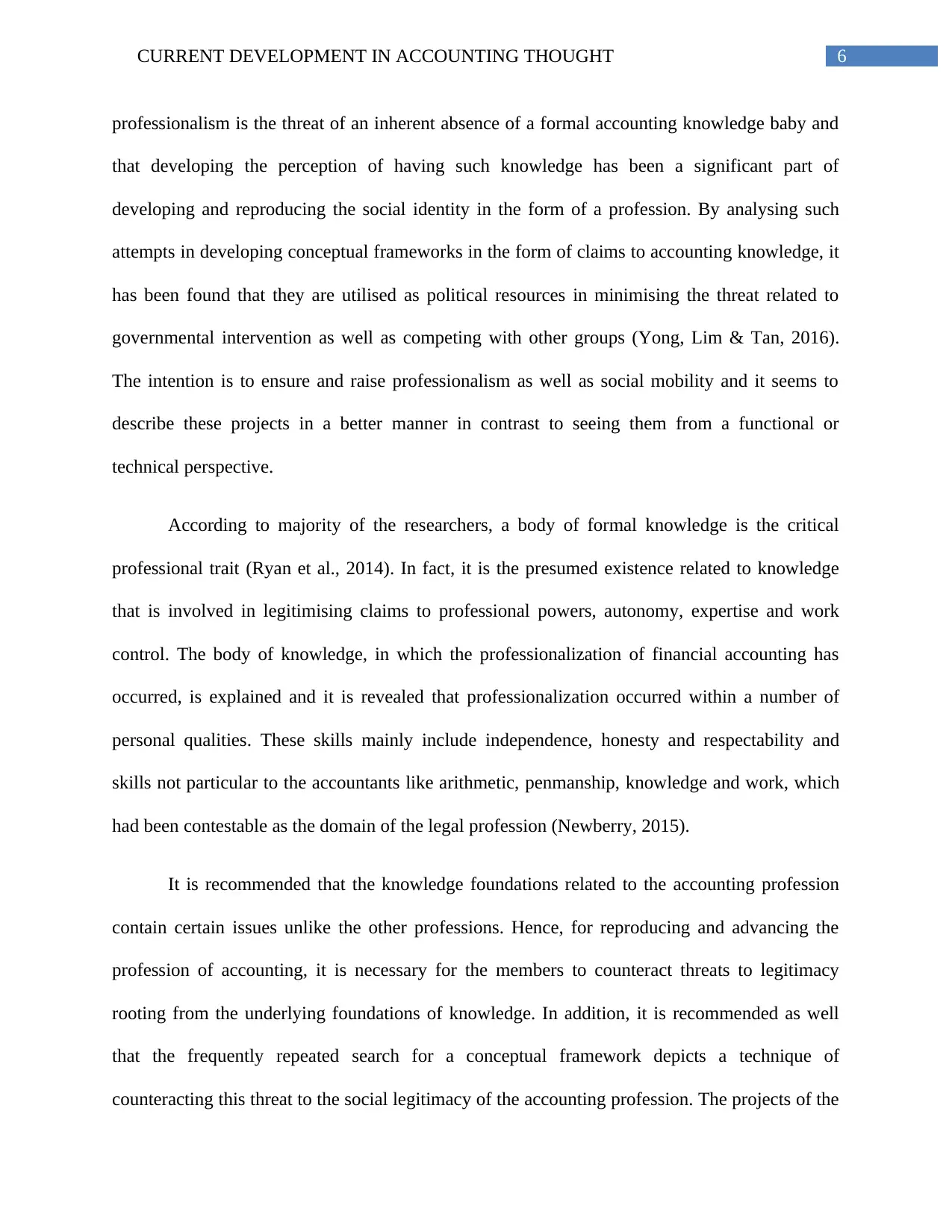
6CURRENT DEVELOPMENT IN ACCOUNTING THOUGHT
professionalism is the threat of an inherent absence of a formal accounting knowledge baby and
that developing the perception of having such knowledge has been a significant part of
developing and reproducing the social identity in the form of a profession. By analysing such
attempts in developing conceptual frameworks in the form of claims to accounting knowledge, it
has been found that they are utilised as political resources in minimising the threat related to
governmental intervention as well as competing with other groups (Yong, Lim & Tan, 2016).
The intention is to ensure and raise professionalism as well as social mobility and it seems to
describe these projects in a better manner in contrast to seeing them from a functional or
technical perspective.
According to majority of the researchers, a body of formal knowledge is the critical
professional trait (Ryan et al., 2014). In fact, it is the presumed existence related to knowledge
that is involved in legitimising claims to professional powers, autonomy, expertise and work
control. The body of knowledge, in which the professionalization of financial accounting has
occurred, is explained and it is revealed that professionalization occurred within a number of
personal qualities. These skills mainly include independence, honesty and respectability and
skills not particular to the accountants like arithmetic, penmanship, knowledge and work, which
had been contestable as the domain of the legal profession (Newberry, 2015).
It is recommended that the knowledge foundations related to the accounting profession
contain certain issues unlike the other professions. Hence, for reproducing and advancing the
profession of accounting, it is necessary for the members to counteract threats to legitimacy
rooting from the underlying foundations of knowledge. In addition, it is recommended as well
that the frequently repeated search for a conceptual framework depicts a technique of
counteracting this threat to the social legitimacy of the accounting profession. The projects of the
professionalism is the threat of an inherent absence of a formal accounting knowledge baby and
that developing the perception of having such knowledge has been a significant part of
developing and reproducing the social identity in the form of a profession. By analysing such
attempts in developing conceptual frameworks in the form of claims to accounting knowledge, it
has been found that they are utilised as political resources in minimising the threat related to
governmental intervention as well as competing with other groups (Yong, Lim & Tan, 2016).
The intention is to ensure and raise professionalism as well as social mobility and it seems to
describe these projects in a better manner in contrast to seeing them from a functional or
technical perspective.
According to majority of the researchers, a body of formal knowledge is the critical
professional trait (Ryan et al., 2014). In fact, it is the presumed existence related to knowledge
that is involved in legitimising claims to professional powers, autonomy, expertise and work
control. The body of knowledge, in which the professionalization of financial accounting has
occurred, is explained and it is revealed that professionalization occurred within a number of
personal qualities. These skills mainly include independence, honesty and respectability and
skills not particular to the accountants like arithmetic, penmanship, knowledge and work, which
had been contestable as the domain of the legal profession (Newberry, 2015).
It is recommended that the knowledge foundations related to the accounting profession
contain certain issues unlike the other professions. Hence, for reproducing and advancing the
profession of accounting, it is necessary for the members to counteract threats to legitimacy
rooting from the underlying foundations of knowledge. In addition, it is recommended as well
that the frequently repeated search for a conceptual framework depicts a technique of
counteracting this threat to the social legitimacy of the accounting profession. The projects of the
Paraphrase This Document
Need a fresh take? Get an instant paraphrase of this document with our AI Paraphraser
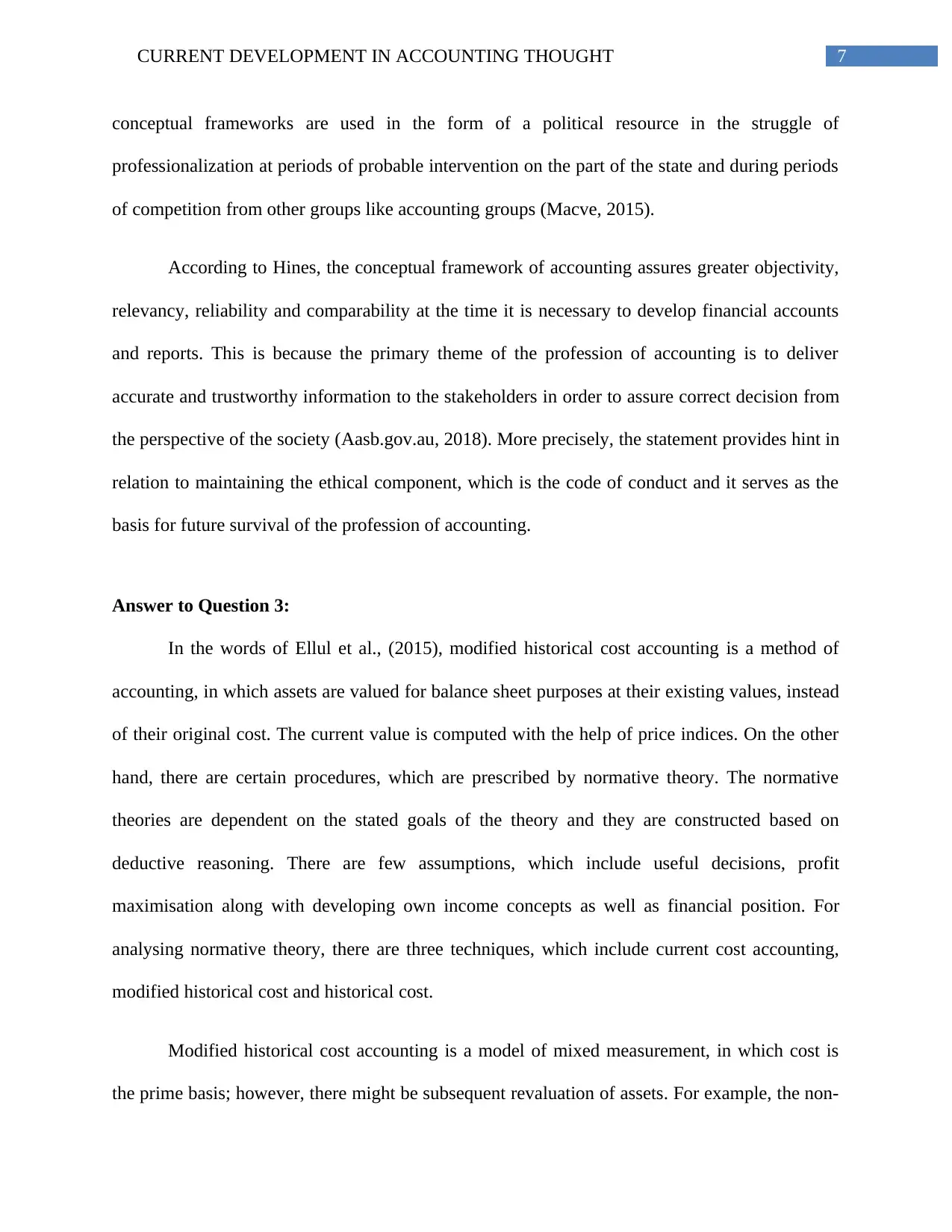
7CURRENT DEVELOPMENT IN ACCOUNTING THOUGHT
conceptual frameworks are used in the form of a political resource in the struggle of
professionalization at periods of probable intervention on the part of the state and during periods
of competition from other groups like accounting groups (Macve, 2015).
According to Hines, the conceptual framework of accounting assures greater objectivity,
relevancy, reliability and comparability at the time it is necessary to develop financial accounts
and reports. This is because the primary theme of the profession of accounting is to deliver
accurate and trustworthy information to the stakeholders in order to assure correct decision from
the perspective of the society (Aasb.gov.au, 2018). More precisely, the statement provides hint in
relation to maintaining the ethical component, which is the code of conduct and it serves as the
basis for future survival of the profession of accounting.
Answer to Question 3:
In the words of Ellul et al., (2015), modified historical cost accounting is a method of
accounting, in which assets are valued for balance sheet purposes at their existing values, instead
of their original cost. The current value is computed with the help of price indices. On the other
hand, there are certain procedures, which are prescribed by normative theory. The normative
theories are dependent on the stated goals of the theory and they are constructed based on
deductive reasoning. There are few assumptions, which include useful decisions, profit
maximisation along with developing own income concepts as well as financial position. For
analysing normative theory, there are three techniques, which include current cost accounting,
modified historical cost and historical cost.
Modified historical cost accounting is a model of mixed measurement, in which cost is
the prime basis; however, there might be subsequent revaluation of assets. For example, the non-
conceptual frameworks are used in the form of a political resource in the struggle of
professionalization at periods of probable intervention on the part of the state and during periods
of competition from other groups like accounting groups (Macve, 2015).
According to Hines, the conceptual framework of accounting assures greater objectivity,
relevancy, reliability and comparability at the time it is necessary to develop financial accounts
and reports. This is because the primary theme of the profession of accounting is to deliver
accurate and trustworthy information to the stakeholders in order to assure correct decision from
the perspective of the society (Aasb.gov.au, 2018). More precisely, the statement provides hint in
relation to maintaining the ethical component, which is the code of conduct and it serves as the
basis for future survival of the profession of accounting.
Answer to Question 3:
In the words of Ellul et al., (2015), modified historical cost accounting is a method of
accounting, in which assets are valued for balance sheet purposes at their existing values, instead
of their original cost. The current value is computed with the help of price indices. On the other
hand, there are certain procedures, which are prescribed by normative theory. The normative
theories are dependent on the stated goals of the theory and they are constructed based on
deductive reasoning. There are few assumptions, which include useful decisions, profit
maximisation along with developing own income concepts as well as financial position. For
analysing normative theory, there are three techniques, which include current cost accounting,
modified historical cost and historical cost.
Modified historical cost accounting is a model of mixed measurement, in which cost is
the prime basis; however, there might be subsequent revaluation of assets. For example, the non-
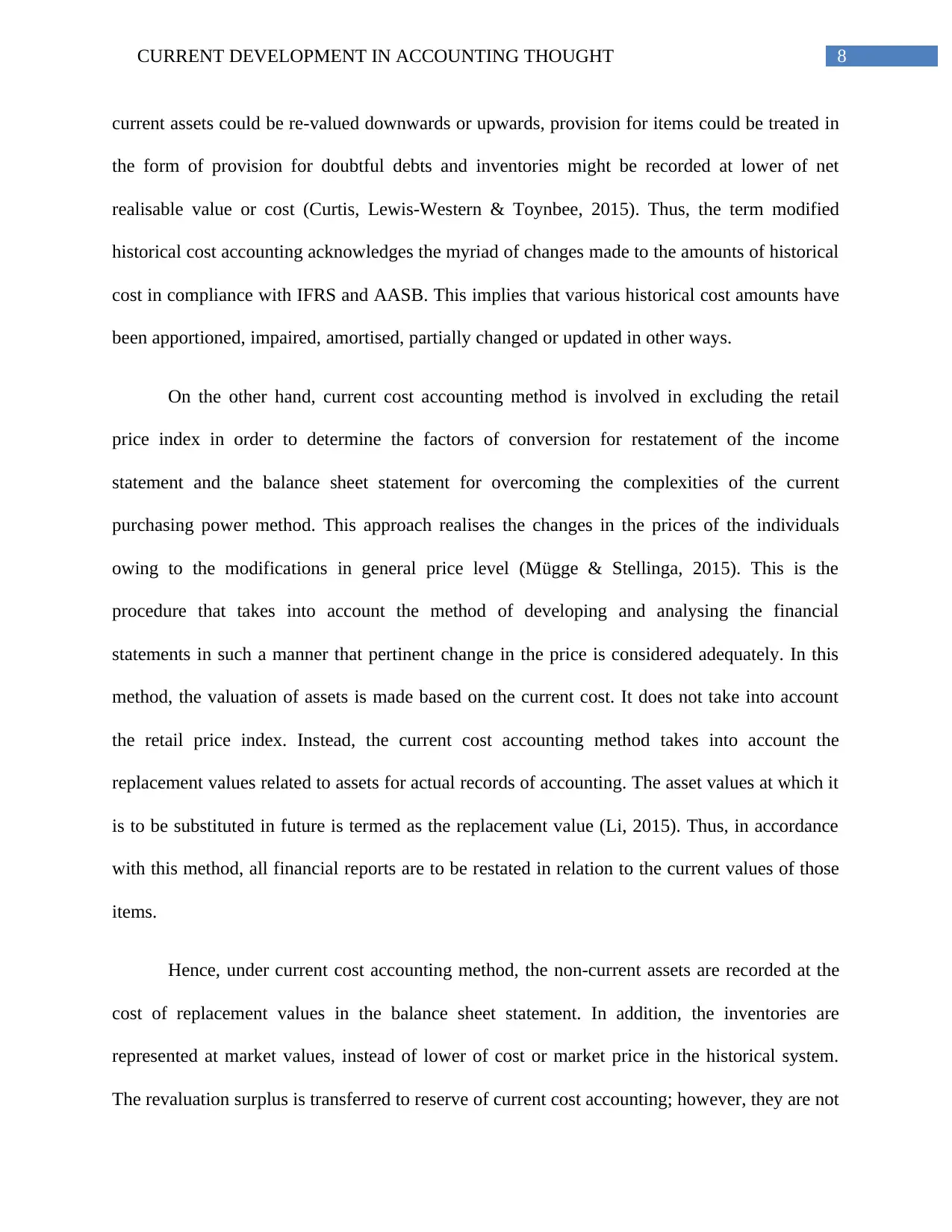
8CURRENT DEVELOPMENT IN ACCOUNTING THOUGHT
current assets could be re-valued downwards or upwards, provision for items could be treated in
the form of provision for doubtful debts and inventories might be recorded at lower of net
realisable value or cost (Curtis, Lewis-Western & Toynbee, 2015). Thus, the term modified
historical cost accounting acknowledges the myriad of changes made to the amounts of historical
cost in compliance with IFRS and AASB. This implies that various historical cost amounts have
been apportioned, impaired, amortised, partially changed or updated in other ways.
On the other hand, current cost accounting method is involved in excluding the retail
price index in order to determine the factors of conversion for restatement of the income
statement and the balance sheet statement for overcoming the complexities of the current
purchasing power method. This approach realises the changes in the prices of the individuals
owing to the modifications in general price level (Mügge & Stellinga, 2015). This is the
procedure that takes into account the method of developing and analysing the financial
statements in such a manner that pertinent change in the price is considered adequately. In this
method, the valuation of assets is made based on the current cost. It does not take into account
the retail price index. Instead, the current cost accounting method takes into account the
replacement values related to assets for actual records of accounting. The asset values at which it
is to be substituted in future is termed as the replacement value (Li, 2015). Thus, in accordance
with this method, all financial reports are to be restated in relation to the current values of those
items.
Hence, under current cost accounting method, the non-current assets are recorded at the
cost of replacement values in the balance sheet statement. In addition, the inventories are
represented at market values, instead of lower of cost or market price in the historical system.
The revaluation surplus is transferred to reserve of current cost accounting; however, they are not
current assets could be re-valued downwards or upwards, provision for items could be treated in
the form of provision for doubtful debts and inventories might be recorded at lower of net
realisable value or cost (Curtis, Lewis-Western & Toynbee, 2015). Thus, the term modified
historical cost accounting acknowledges the myriad of changes made to the amounts of historical
cost in compliance with IFRS and AASB. This implies that various historical cost amounts have
been apportioned, impaired, amortised, partially changed or updated in other ways.
On the other hand, current cost accounting method is involved in excluding the retail
price index in order to determine the factors of conversion for restatement of the income
statement and the balance sheet statement for overcoming the complexities of the current
purchasing power method. This approach realises the changes in the prices of the individuals
owing to the modifications in general price level (Mügge & Stellinga, 2015). This is the
procedure that takes into account the method of developing and analysing the financial
statements in such a manner that pertinent change in the price is considered adequately. In this
method, the valuation of assets is made based on the current cost. It does not take into account
the retail price index. Instead, the current cost accounting method takes into account the
replacement values related to assets for actual records of accounting. The asset values at which it
is to be substituted in future is termed as the replacement value (Li, 2015). Thus, in accordance
with this method, all financial reports are to be restated in relation to the current values of those
items.
Hence, under current cost accounting method, the non-current assets are recorded at the
cost of replacement values in the balance sheet statement. In addition, the inventories are
represented at market values, instead of lower of cost or market price in the historical system.
The revaluation surplus is transferred to reserve of current cost accounting; however, they are not
⊘ This is a preview!⊘
Do you want full access?
Subscribe today to unlock all pages.

Trusted by 1+ million students worldwide
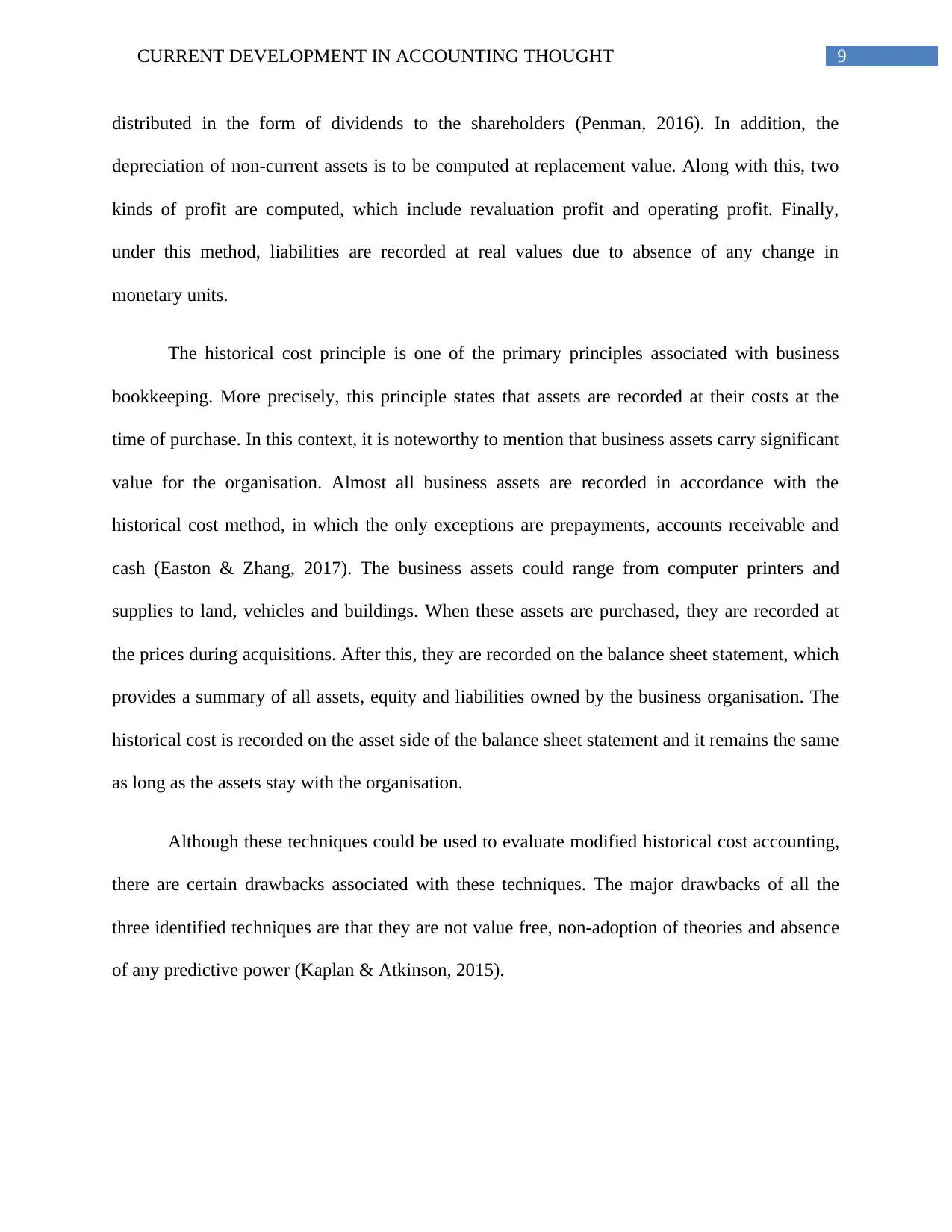
9CURRENT DEVELOPMENT IN ACCOUNTING THOUGHT
distributed in the form of dividends to the shareholders (Penman, 2016). In addition, the
depreciation of non-current assets is to be computed at replacement value. Along with this, two
kinds of profit are computed, which include revaluation profit and operating profit. Finally,
under this method, liabilities are recorded at real values due to absence of any change in
monetary units.
The historical cost principle is one of the primary principles associated with business
bookkeeping. More precisely, this principle states that assets are recorded at their costs at the
time of purchase. In this context, it is noteworthy to mention that business assets carry significant
value for the organisation. Almost all business assets are recorded in accordance with the
historical cost method, in which the only exceptions are prepayments, accounts receivable and
cash (Easton & Zhang, 2017). The business assets could range from computer printers and
supplies to land, vehicles and buildings. When these assets are purchased, they are recorded at
the prices during acquisitions. After this, they are recorded on the balance sheet statement, which
provides a summary of all assets, equity and liabilities owned by the business organisation. The
historical cost is recorded on the asset side of the balance sheet statement and it remains the same
as long as the assets stay with the organisation.
Although these techniques could be used to evaluate modified historical cost accounting,
there are certain drawbacks associated with these techniques. The major drawbacks of all the
three identified techniques are that they are not value free, non-adoption of theories and absence
of any predictive power (Kaplan & Atkinson, 2015).
distributed in the form of dividends to the shareholders (Penman, 2016). In addition, the
depreciation of non-current assets is to be computed at replacement value. Along with this, two
kinds of profit are computed, which include revaluation profit and operating profit. Finally,
under this method, liabilities are recorded at real values due to absence of any change in
monetary units.
The historical cost principle is one of the primary principles associated with business
bookkeeping. More precisely, this principle states that assets are recorded at their costs at the
time of purchase. In this context, it is noteworthy to mention that business assets carry significant
value for the organisation. Almost all business assets are recorded in accordance with the
historical cost method, in which the only exceptions are prepayments, accounts receivable and
cash (Easton & Zhang, 2017). The business assets could range from computer printers and
supplies to land, vehicles and buildings. When these assets are purchased, they are recorded at
the prices during acquisitions. After this, they are recorded on the balance sheet statement, which
provides a summary of all assets, equity and liabilities owned by the business organisation. The
historical cost is recorded on the asset side of the balance sheet statement and it remains the same
as long as the assets stay with the organisation.
Although these techniques could be used to evaluate modified historical cost accounting,
there are certain drawbacks associated with these techniques. The major drawbacks of all the
three identified techniques are that they are not value free, non-adoption of theories and absence
of any predictive power (Kaplan & Atkinson, 2015).
Paraphrase This Document
Need a fresh take? Get an instant paraphrase of this document with our AI Paraphraser
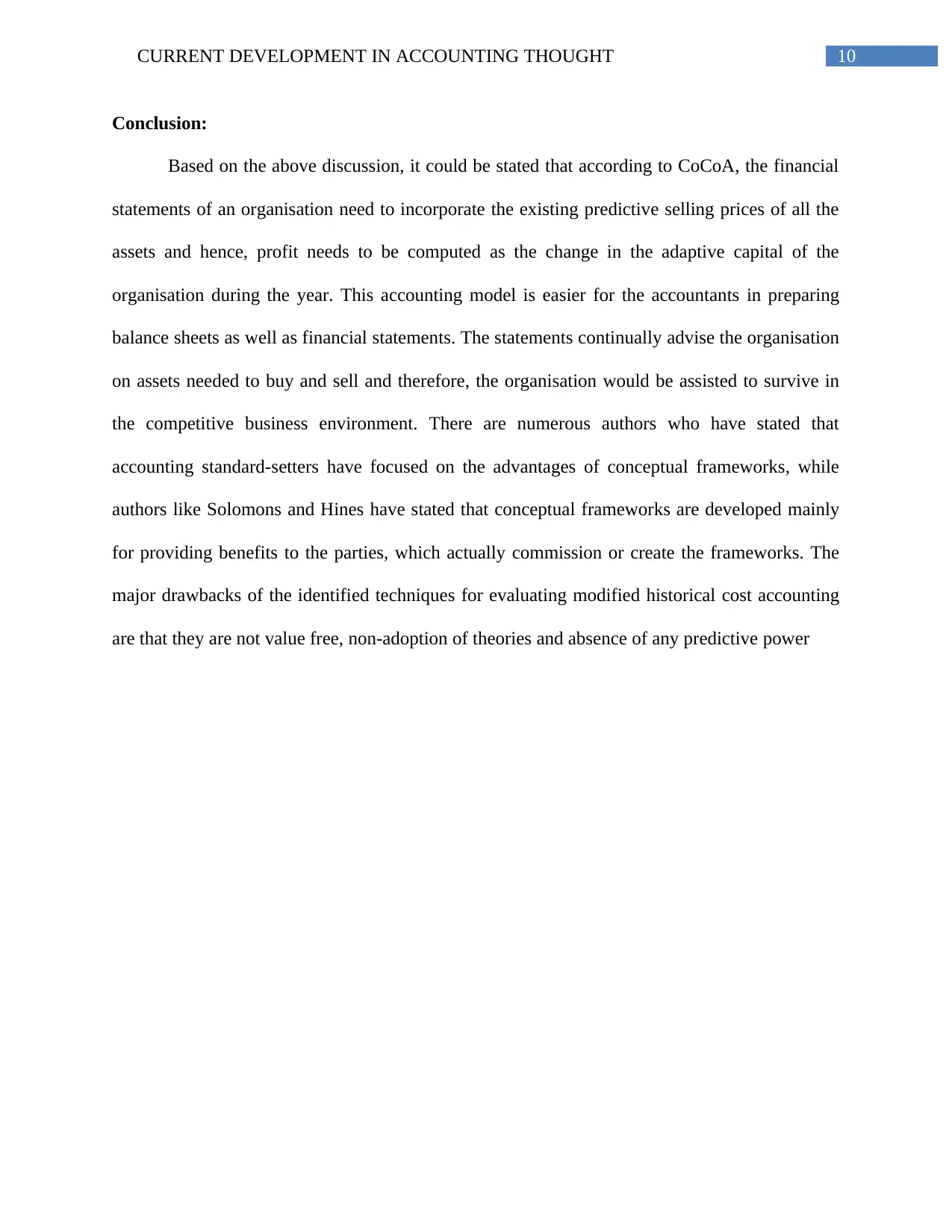
10CURRENT DEVELOPMENT IN ACCOUNTING THOUGHT
Conclusion:
Based on the above discussion, it could be stated that according to CoCoA, the financial
statements of an organisation need to incorporate the existing predictive selling prices of all the
assets and hence, profit needs to be computed as the change in the adaptive capital of the
organisation during the year. This accounting model is easier for the accountants in preparing
balance sheets as well as financial statements. The statements continually advise the organisation
on assets needed to buy and sell and therefore, the organisation would be assisted to survive in
the competitive business environment. There are numerous authors who have stated that
accounting standard-setters have focused on the advantages of conceptual frameworks, while
authors like Solomons and Hines have stated that conceptual frameworks are developed mainly
for providing benefits to the parties, which actually commission or create the frameworks. The
major drawbacks of the identified techniques for evaluating modified historical cost accounting
are that they are not value free, non-adoption of theories and absence of any predictive power
Conclusion:
Based on the above discussion, it could be stated that according to CoCoA, the financial
statements of an organisation need to incorporate the existing predictive selling prices of all the
assets and hence, profit needs to be computed as the change in the adaptive capital of the
organisation during the year. This accounting model is easier for the accountants in preparing
balance sheets as well as financial statements. The statements continually advise the organisation
on assets needed to buy and sell and therefore, the organisation would be assisted to survive in
the competitive business environment. There are numerous authors who have stated that
accounting standard-setters have focused on the advantages of conceptual frameworks, while
authors like Solomons and Hines have stated that conceptual frameworks are developed mainly
for providing benefits to the parties, which actually commission or create the frameworks. The
major drawbacks of the identified techniques for evaluating modified historical cost accounting
are that they are not value free, non-adoption of theories and absence of any predictive power
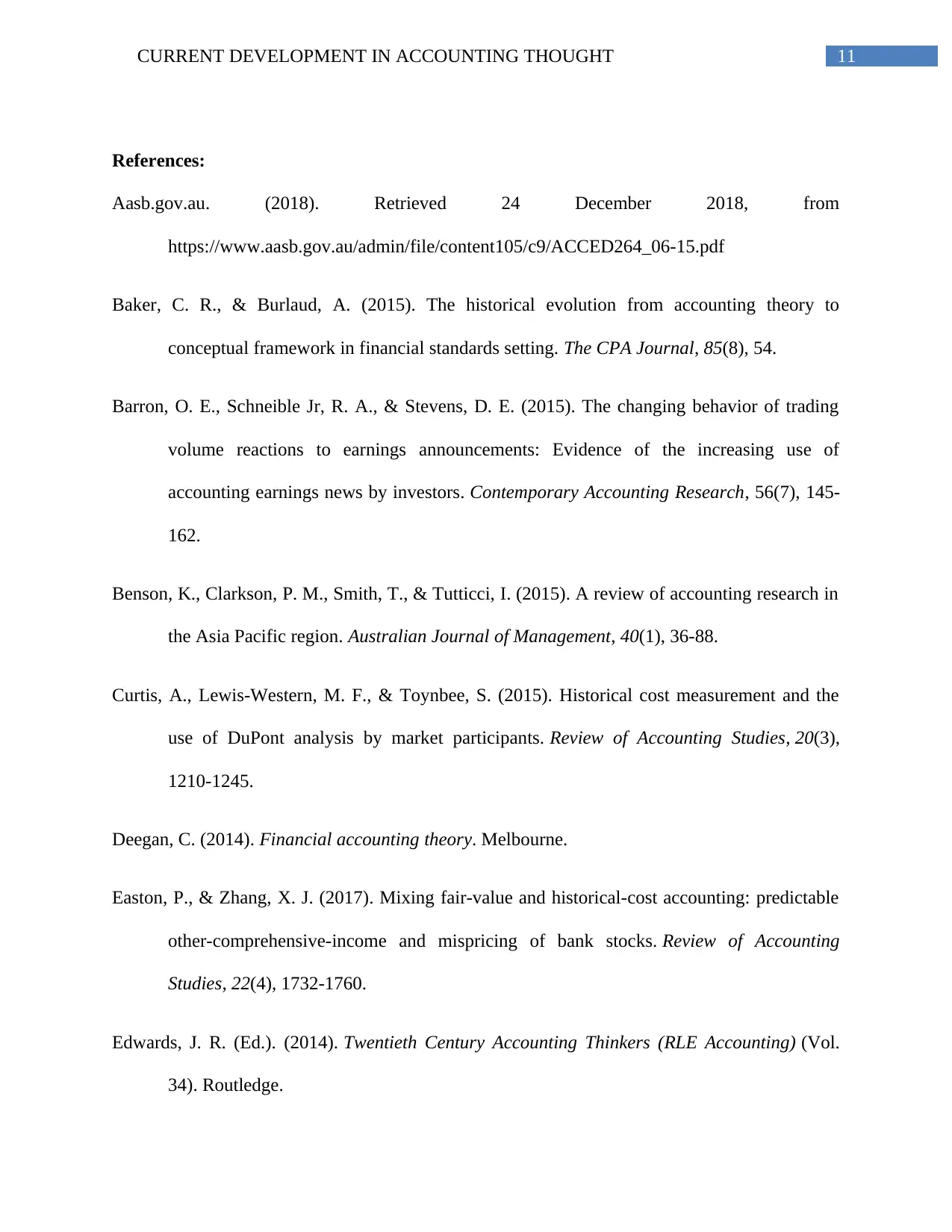
11CURRENT DEVELOPMENT IN ACCOUNTING THOUGHT
References:
Aasb.gov.au. (2018). Retrieved 24 December 2018, from
https://www.aasb.gov.au/admin/file/content105/c9/ACCED264_06-15.pdf
Baker, C. R., & Burlaud, A. (2015). The historical evolution from accounting theory to
conceptual framework in financial standards setting. The CPA Journal, 85(8), 54.
Barron, O. E., Schneible Jr, R. A., & Stevens, D. E. (2015). The changing behavior of trading
volume reactions to earnings announcements: Evidence of the increasing use of
accounting earnings news by investors. Contemporary Accounting Research, 56(7), 145-
162.
Benson, K., Clarkson, P. M., Smith, T., & Tutticci, I. (2015). A review of accounting research in
the Asia Pacific region. Australian Journal of Management, 40(1), 36-88.
Curtis, A., Lewis-Western, M. F., & Toynbee, S. (2015). Historical cost measurement and the
use of DuPont analysis by market participants. Review of Accounting Studies, 20(3),
1210-1245.
Deegan, C. (2014). Financial accounting theory. Melbourne.
Easton, P., & Zhang, X. J. (2017). Mixing fair-value and historical-cost accounting: predictable
other-comprehensive-income and mispricing of bank stocks. Review of Accounting
Studies, 22(4), 1732-1760.
Edwards, J. R. (Ed.). (2014). Twentieth Century Accounting Thinkers (RLE Accounting) (Vol.
34). Routledge.
References:
Aasb.gov.au. (2018). Retrieved 24 December 2018, from
https://www.aasb.gov.au/admin/file/content105/c9/ACCED264_06-15.pdf
Baker, C. R., & Burlaud, A. (2015). The historical evolution from accounting theory to
conceptual framework in financial standards setting. The CPA Journal, 85(8), 54.
Barron, O. E., Schneible Jr, R. A., & Stevens, D. E. (2015). The changing behavior of trading
volume reactions to earnings announcements: Evidence of the increasing use of
accounting earnings news by investors. Contemporary Accounting Research, 56(7), 145-
162.
Benson, K., Clarkson, P. M., Smith, T., & Tutticci, I. (2015). A review of accounting research in
the Asia Pacific region. Australian Journal of Management, 40(1), 36-88.
Curtis, A., Lewis-Western, M. F., & Toynbee, S. (2015). Historical cost measurement and the
use of DuPont analysis by market participants. Review of Accounting Studies, 20(3),
1210-1245.
Deegan, C. (2014). Financial accounting theory. Melbourne.
Easton, P., & Zhang, X. J. (2017). Mixing fair-value and historical-cost accounting: predictable
other-comprehensive-income and mispricing of bank stocks. Review of Accounting
Studies, 22(4), 1732-1760.
Edwards, J. R. (Ed.). (2014). Twentieth Century Accounting Thinkers (RLE Accounting) (Vol.
34). Routledge.
⊘ This is a preview!⊘
Do you want full access?
Subscribe today to unlock all pages.

Trusted by 1+ million students worldwide
1 out of 14
Related Documents
Your All-in-One AI-Powered Toolkit for Academic Success.
+13062052269
info@desklib.com
Available 24*7 on WhatsApp / Email
![[object Object]](/_next/static/media/star-bottom.7253800d.svg)
Unlock your academic potential
Copyright © 2020–2025 A2Z Services. All Rights Reserved. Developed and managed by ZUCOL.




